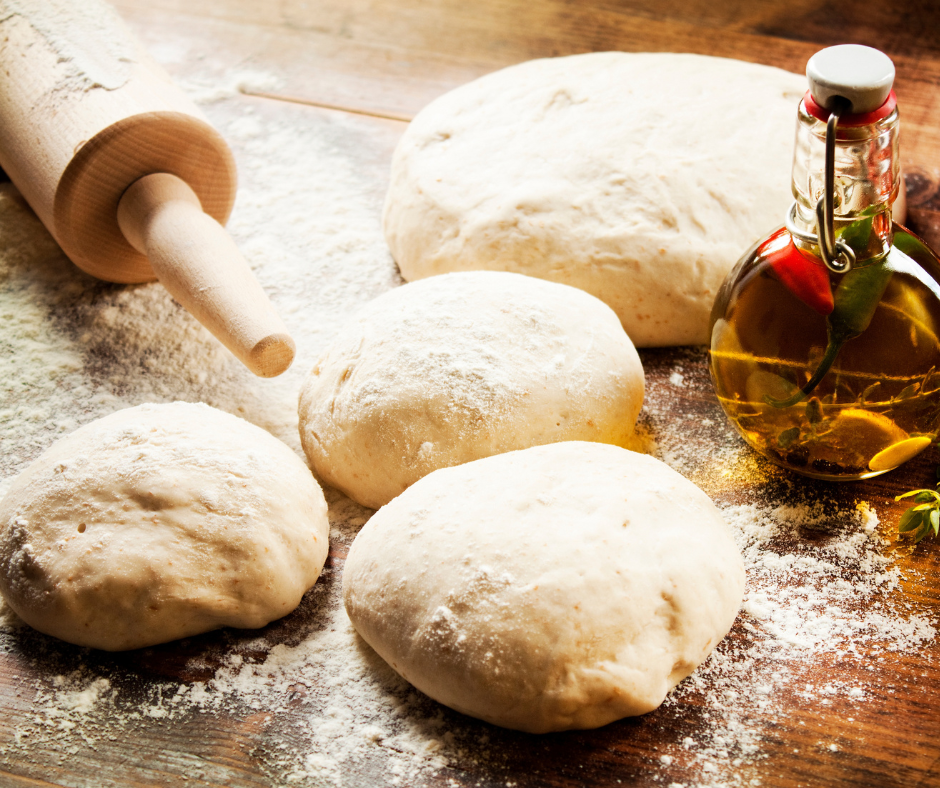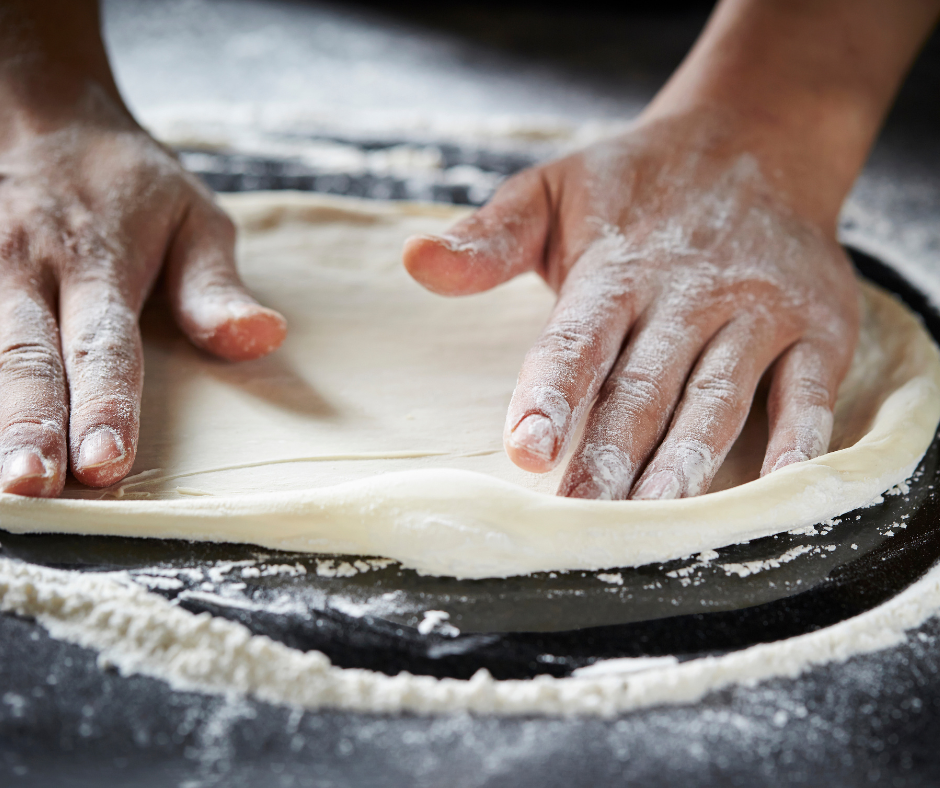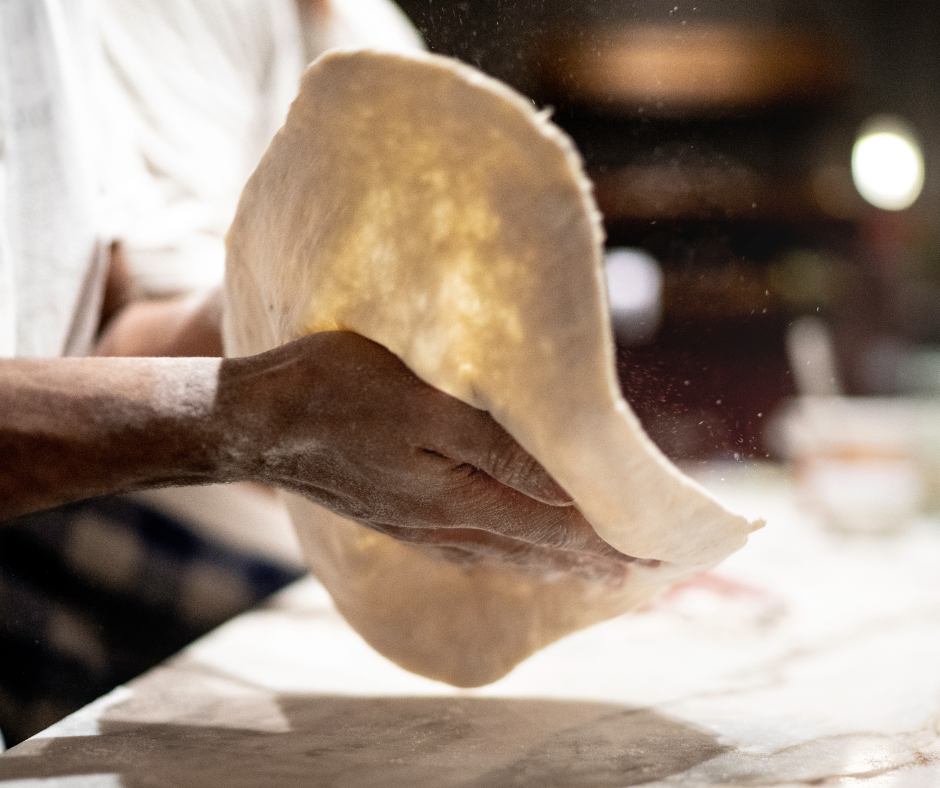Introduction
For pizza lovers and aspiring pizzaiolos, there’s nothing quite as frustrating as dealing with sticky pizza dough. So, Should Pizza Dough Be Sticky? A common issue can make the pizza-making process challenging and messy. But fear not because we’re here to tackle the sticky situation and provide some insights on dough consistency.
Should Pizza Dough Be Sticky?
Sticky pizza dough is often a result of excessive hydration, meaning that there is too much water in the dough compared to the amount of flour used. This can happen when measuring ingredients imprecisely or when the dough is over-kneaded. It can also be influenced by atmospheric conditions, such as high humidity, which affects the moisture content of the dough.
Understanding The Importance Of Dough Consistency
The consistency of pizza dough is crucial for achieving the perfect crust. Whether you prefer a thin and crispy crust or a thick and chewy one, the right consistency is key. Here are a few reasons why dough consistency matters:
- Ease of handling: Sticky dough can be difficult to work with, making it challenging to shape and stretch it into a desired size and thickness. A well-hydrated yet non-sticky dough is much easier to handle and shape.
- Texture: The texture of the final crust is greatly influenced by the consistency of the dough. Sticky dough can result in a gummy or dense crust, while a properly hydrated dough produces a light and airy texture.
- Baking time and temperature: Dough consistency affects the baking time and temperature needed to achieve the desired crust. Sticky dough may require longer baking time and lower temperatures to thoroughly cook the crust without burning.
- Uniform rising: Consistent dough consistency ensures that the dough rises evenly during the proofing process, resulting in an evenly textured crust.
Remember, achieving the right consistency takes practice and experimentation. As you become more familiar with the pizza-making process, you’ll learn to adjust ingredients and techniques to achieve the perfect dough consistency for your preferred pizza style.
Factors That Affect Pizza Dough Stickiness
Moisture Content In The Dough
When making pizza dough, the amount of water you use can greatly impact its stickiness. If the dough feels too sticky, it could be due to excess moisture. In this case, consider adding more flour to balance out the consistency. However, if the dough feels dry and hard to work with, adding more water can help soften it.
Proper Flour-to-water Ratio For Pizza Dough
The right balance between flour and water is crucial when making non-sticky pizza dough. The ideal ratio is typically around 2:1, meaning you’ll need twice as much flour as water. However, this can vary depending on the recipe or the type of flour used. It’s always a good idea to start with the recommended ratio and adjust as needed to achieve the desired texture.
The Type Of Flour Used In The Dough
Different types of flour have different levels of gluten, which can affect the stickiness of the dough. High-gluten flours, such as bread or strong flour, produce stickier dough. On the other hand, using all-purpose flour or a mix of all-purpose flour and bread flour can result in a less sticky dough. Experiment with different types of flour to find the one that works best for you.
You can tackle the sticky situation when making pizza dough by understanding these factors. Remember, it’s all about finding the right balance of moisture, flour-to-water ratio, and the type of flour. Don’t be afraid to experiment and adjust the recipe to achieve the desired texture. You can make perfect, non-sticky pizza dough every time with a little practice and patience. Happy baking!
The Role Of Gluten In Pizza Dough Stickiness
How Gluten Affects The Texture Of Pizza Dough
When it comes to making pizza dough, one of the factors that affects its stickiness is the gluten content. Gluten is a protein in wheat flour that gives the dough an elastic and stretchy texture. Gluten formation occurs when the proteins gliadin and glutenin combine and form a network, providing structure to the dough. Gluten also plays a key role in trapping air bubbles, which gives pizza dough its desired light and airy texture.
The Significance Of Gluten Development In Reducing Stickiness
Proper gluten development is crucial in reducing stickiness in pizza dough. When gluten is insufficiently developed, the dough may be more prone to sticking to surfaces and difficult to handle. On the other hand, when gluten is properly developed, it gives the dough strength and elasticity, making it easier to stretch and shape.
To develop gluten in pizza dough, it is important to knead it thoroughly. This process helps the gluten proteins combine and form a strong network. Kneading also helps distribute moisture evenly throughout the dough, which further aids in reducing stickiness.
Additionally, allowing the dough to rest and rise after kneading helps relax the gluten, making it less prone to sticking. The resting time allows the gluten network to relax and become more extensible, resulting in a smoother and less sticky dough.
In conclusion, gluten plays a crucial role in the texture and stickiness of pizza dough. Proper gluten development through thorough kneading and resting can help reduce stickiness and make the dough easier to handle and shape. So, the next time you make pizza dough, give gluten the attention it deserves for a less sticky and more enjoyable pizza-making experience.
Techniques For Dealing With Sticky Pizza Dough
Anyone who has attempted to make pizza dough from scratch knows the frustration of dealing with sticky dough. But Should Pizza Dough Be Sticky? But fear not! You can try several techniques to tackle this sticky situation and achieve the perfect pizza crust.
Adjusting The Flour-to-water Ratio
One of the main reasons dough becomes sticky is an imbalance in the flour-to-water ratio. Adding more flour can help absorb the excess moisture and reduce stickiness. Gradually add small flour to the dough until it reaches the desired consistency. Adding more flour than liquid is easier, so go slowly to avoid making the dough too dry.
Kneading And Resting Dough For Gluten Development
Kneading the dough helps develop gluten, which gives the dough structure and elasticity. You can improve its texture and reduce stickiness by kneading the dough properly and allowing it to rest. Start by kneading the dough on a lightly floured surface, using the heel of your hand to push it away from you, then fold it over and repeat. Continue this process for several minutes until the dough becomes smooth and elastic. After kneading, let the dough rest for 15-30 minutes to relax the gluten.
Incorporating Additional Flour Or Oil For Desired Consistency
If adjusting the flour-to-water ratio and kneading isn’t enough to eliminate the stickiness, you can try incorporating additional flour or oil. Adding small amounts of flour or oil at a time can help achieve the desired consistency. Sprinkle a little flour onto the dough or drizzle some oil onto your hands and gently work it into the dough. Be cautious not to add too much, as it can alter the texture and flavor of the final product.
Remember, the goal is to achieve a slightly tacky and pliable dough, not sticky and unworkable. Practice and experimentation are key to finding the right balance. So, don’t let sticky pizza dough discourage you from making homemade pizza. With these techniques, you’ll be well on your way to perfecting your pizza crust.
The Impact Of Rising And Proofing On Dough Stickiness
The Role Of Temperature And Time In Dough Fermentation
When making pizza dough, one of the common challenges many home cooks and even professional chefs face is dealing with sticky dough. Should pizza dough be sticky? The answer is that it depends on various factors, including the rising and proofing process.
The yeast converts sugars into carbon dioxide during fermentation, causing the dough to rise. Temperature and time play a crucial role in this process. If the dough is fermented at a higher temperature, it will rise faster, resulting in a stickier texture. On the other hand, a lower temperature will slow the fermentation and produce a less sticky dough.
How Proper Rising And Proofing Can Improve Dough Texture
To tackle the sticky situation, proper rising and proofing techniques are essential. Here are some tips to help improve your dough texture:
- Use a cold rise: You slow the fermentation process by allowing the dough to rise in the refrigerator overnight, leading to a less sticky dough. This method enhances flavor development while controlling stickiness.
- Adjust hydration levels: Sticky dough can sometimes result from too much water in the recipe. Experiment with reducing the hydration level slightly by adding less water during the initial mixing stage. This can help achieve a less sticky dough.
- Incorporate folding techniques: During the rising process, gently fold the dough over itself to redistribute the yeast and release excess gas. This technique helps strengthen the gluten structure and can reduce stickiness.
Remember, dough stickiness can also be influenced by the type of flour used, humidity levels, and even the brand of yeast. Finding the perfect balance for your desired crust texture may require trial and error.
In conclusion, stickiness can be managed through proper rising and proofing techniques for pizza dough. Understanding the role of temperature and time in fermentation and incorporating adjustments to hydration levels and folding techniques can help you achieve the texture you desire for your pizza crust. So next time you’re facing a sticky situation, don’t worry; there are solutions to make your pizza dough less sticky and more enjoyable.
Troubleshooting Sticky Pizza Dough
Pizza dough can be a tricky beast to conquer, especially when it becomes sticky and difficult to work with. But fear not; with a little knowledge and some simple techniques, you can conquer this sticky situation and create the perfect pizza crust. Here are some common mistakes to avoid and tips for handling sticky dough without affecting its texture.
Common Mistakes To Avoid
- Overhydration: Adding too much water or liquid ingredients to your dough can make it sticky. It’s important to follow the recipe and measure your ingredients accurately.
- Insufficient kneading: Proper kneading is essential to develop gluten, which gives the dough structure and elasticity. Insufficient kneading can result in a sticky dough.
- Using too much flour: While it may be tempting to keep adding flour to the dough to reduce stickiness, it can make the dough dry and tough. Use flour sparingly and other techniques to handle sticky dough instead.
Tips For Handling Sticky Dough Without Affecting Texture
- Oil your hands and work surface: Rubbing a small amount of olive oil on your hands and work surface can help prevent the dough from sticking. Avoid using flour as much as possible, as it can alter the texture of the final crust.
- Use a dough scraper: A dough scraper is a handy tool for handling sticky dough. It allows you to lift and fold the dough without touching it directly, preventing it from sticking to your hands.
- Refrigerate the dough: If it is extremely sticky, place it in the refrigerator for 30 minutes to an hour. Chilling the dough can firm it up and make it easier to handle.
- Adjust hydration: If you consistently have issues with sticky dough, you may need to adjust the hydration level of your recipe. Gradually add less water or liquid ingredients until you achieve a dough that is easier to work with.
You can tackle sticky pizza dough like a pro by avoiding common mistakes and utilizing these helpful tips. Remember, practice makes perfect, so don’t get discouraged if it takes a few tries to get it right. Happy pizza making!
Conclusion
Now you should know the answer to ‘Should Pizza Dough Be Sticky?’. While sticky pizza dough may initially seem problematic, it can lead to delicious pizza crusts if handled correctly. By experimenting with different techniques and understanding the science behind dough consistency, you can achieve the perfect balance of stickiness and elasticity for your pizza dough. Don’t be discouraged if your dough is sticky – it’s all about finding the right methods that work for you.
Why Sticky Dough Can Still Result In Delicious Pizza Crusts
Sticky dough should not be seen as a negative, as it can lead to light, airy, and chewy crusts. The stickiness of the dough can be attributed to the higher hydration levels, which allow the yeast to work its magic and create those coveted air pockets in the crust. These air pockets contribute to a lighter texture and enhanced flavor. So, embrace the stickiness and trust in fermentation to yield a delicious pizza crust.
Experimenting With Different Techniques For Optimal Dough Consistency
If you prefer less sticky dough, there are several techniques you can try to achieve the desired consistency. Adjusting the amount of water used, gradually adding the flour to the dough, and incorporating a longer resting time during the proofing process can all help reduce stickiness. It’s important to note that pizza dough recipes may require different approaches, so don’t be afraid to experiment and find what works best for you.
Frequently Asked Questions About Sticky Pizza Dough
Why is my dough too sticky? Sticky dough can be caused by using too much water or not enough flour in your recipe. The humidity in your environment can also affect the stickiness of the dough.
Can I add more flour to reduce stickiness? Adding more flour to your sticky dough can help reduce stickiness, but be cautious not to add too much, as it can result in a dense and heavy crust.
How can I prevent my dough from sticking to the countertop? Lightly dusting your countertop with flour or using parchment paper can help prevent the dough from sticking during the stretching and shaping process.
Remember, pizza making is a craft, and sticky dough is just one of the many obstacles to overcome. With practice and experimentation, you can master the art of pizza dough and create delicious, homemade pizzas that will rival any pizzeria. So don’t fret over sticky dough – embrace it as part of the process and keep striving for pizza perfection.

Looking for delicious pizza and authentic Italian cuisine? Look no further than Claudia R. Diaz at Joe’s NY Pizza in Tonawanda! Our menu features a wide variety of classic dishes and innovative creations, all made with the freshest ingredients and prepared with the utmost care. Whether you’re in the mood for a traditional Margherita pizza or something a little more adventurous, like our Buffalo chicken pizza or shrimp scampi pasta, Claudia R. Diaz has something to satisfy every craving. So why wait? Visit us today and experience the best Italian food in Tonawanda! #ClaudiaRDiaz #JoesNYPizzaTonawanda #ItalianFood #PizzaLovers #FoodiesUnite



